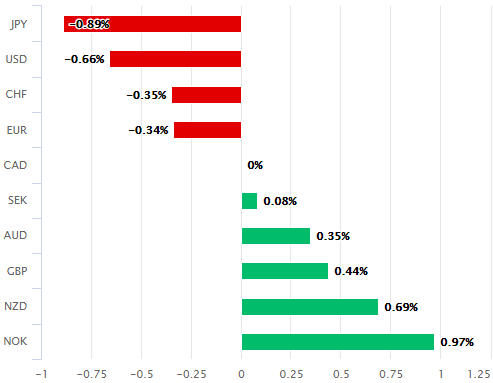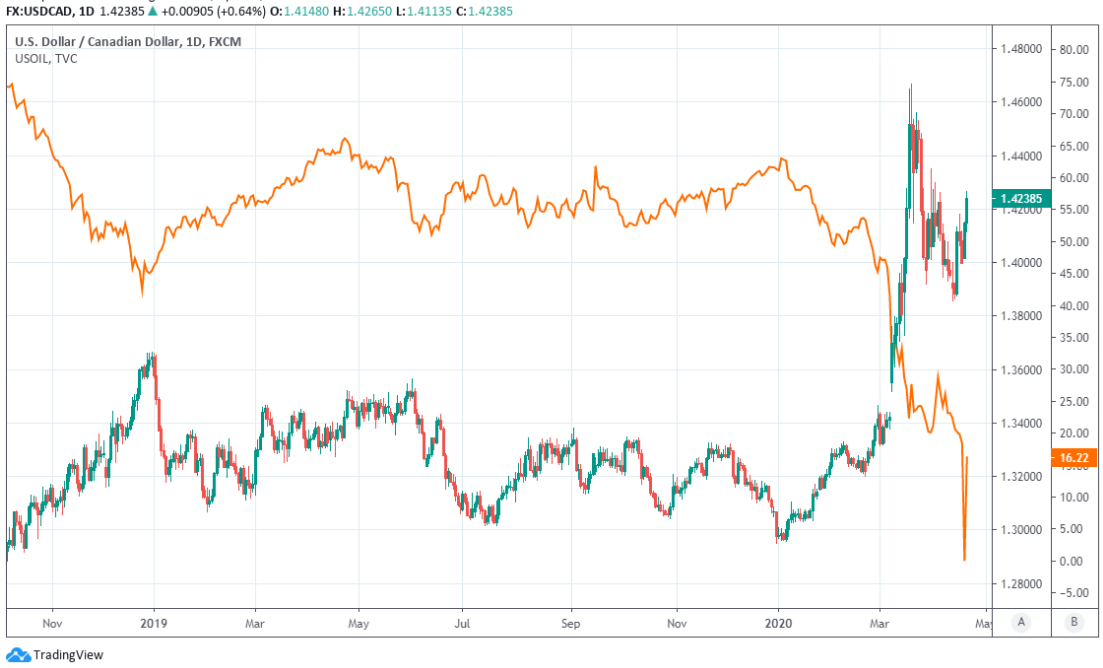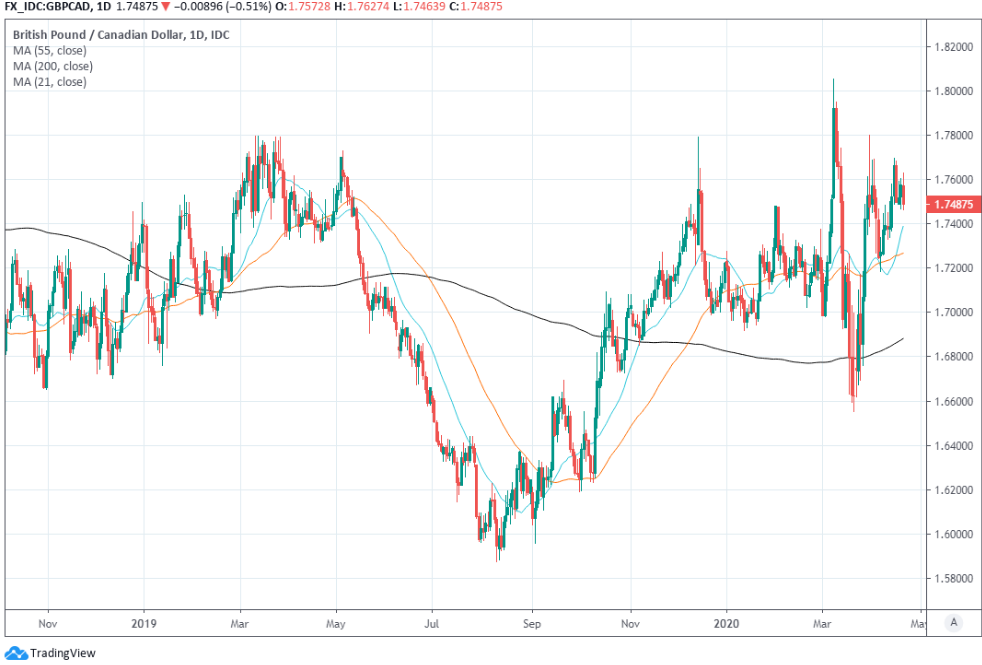Canadian Dollar Oil Woes Are In the Price but Upside Limited For Now
- Written by: James Skinner
-
- CAD gains on GBP, AUD, NZD, SEK, NOK despite oil woes.
- June WTI futures lose $6 on Tuesday but CAD outperforms.
- Near-term destruction in price but still medium-term matters.
- Q3, Q4 and 2020 recovery outlooks key for oil, CAD outlooks.

Image © Adobe Stock
- GBP/CAD spot at time of writing: 1.7517
- Bank transfer rates (indicative): 1.6880-1.7002
- FX specialist rates (indicative): 1.7230-1.7335 >> Get your quote now
The Canadian Dollar outperformed risky counterparts Tuesday despite ongoing turmoil in the oil futures market, suggesting the Loonie may already be discounting the crude calamity although analysts say the upside is limited for now and that downside risks will abound at least until summer.
Crude oil futures prices fell to zero and then below on Monday as contracts for the May month came close to expiry and in the process, revealed a wide gap between prices of barrels bought on the day and barrels bought for some time in the future. Oil futures for next month settled at -$37.63 on Monday due to a supply glut induced by the coronavirus shutdown which has grown so significant that oil producers now need to pay customers to take their barrels.
Storage capacity constraints are at critical levels after weeks of a global economic shutdown that's sidelined an overwhelming slice of global demand and so much so that the cost of disposing of a barrel of oil now exceeds its value in use, which is bad news for Canada's number one export. But investors knew the oil market and Canadian Dollar had a big problem on their hands before this price action hence the limited reaction from the Loonie.
"The market is looking past the distortions in the front-end and paying more attention down the futures curve," says Bipan Rai, North American head of FX strategy at CIBC Capital Markets. "Sensitivity is higher towards the longer-dated contracts. If those start falling, then you'll see a bigger reaction in FX."

Above: Canadian Dollar performance relative to major rivals on Tuesday. Source: Pound Sterling Live.
Canada's Dollar was quoted higher against the Pound, the Swedish Krona, Australian Dollar, New Zealand Dollar and Norwegian Krone in the major currency space on Tuesday, while ceding ground to the big Dollar as well as Japanese Yen and Euro. This was despite an -18% decline for prices of Brent crude oil futures, the global benchmark, and June WTI futures prices that fell from $22 per barrel to $16.44 just hours after expiry of the May contracts. June's ICE futures are set to expire on May 18.
The global economy faces a steep contraction for the first quarter that should be quantified slowly but surely through the April and May months as official data make their way to the market, although the second-quarter slump is expected to be even steeper given that 'lockdown' measures were not implemented in the most major economies until late March, although the size of this slump will not be known for sure until some time in August given a 60-day lag to period end before data are released in most countries.
"While the risk mood in markets has improved since North American equities bottomed close to four weeks ago, the still uncertain impact of the COVID-19 lockdown and an even more uncertain path to recovery are set to check the value of the CAD at least until the beginning of summer. Crude oil prices appear to have stabilised but remain weak near the $20/bbl mark with OPEC+ (plus) supply cuts seen as insufficient to boost prices. We expect that amid ongoing uncertainty and soft commodity prices, USDCAD is likely to remain above the 1.40 mark until the latter third of the year, for an end-2020 target of 1.38," says Shaun Osborne, chief FX strategist at Scotiabank.
Above: USD/CAD rate shown at daily intervals alongside WTRI crude oil futures price (orange line).
There are forecasts aplenty for how large the first and second quarter declines in output are likely to be and Tuesday's price action suggests strongly that both Canadian Dollar and oil traders already have an idea of what to expect. However, what's less certain is the likely scale of the recovery in the third and final quarters as well as in 2021, which are what matter for prices of longer-dated futures contracts and the performance of the Loonie.
The U.S. and Germany are attempting this week to reopen parts of their economies that were either least affected by the coronavirus crisis or those quickest to recover from it, butothers including the UK, Canada, Italy and Spain are still some way off from a return to normal. It's the pace of normalisation in those latter countries that could matter most to expectations for third and final quarter as well as 2021 global growth.
"In the absence of a meaningful demand recovery, negative prices could return for June WTI contracts in May. Given the experience of negative WTI oil prices yesterday, unless the US is willing to move towards mandated cuts (markets will thus closely watch The Texas Railroad Commission meeting today) the upside to currencies of oil exporters (as well as other commodity currencies that will ultimately feel the spillover) should be limited," says Petr Krpata, chief EMEA strategist for currencies and bonds at ING.
Above: Pound-Canadian Dollar rate shown at daily intervals alongside 21, 55 and 200-day (black line) moving-averages.
USD/CAD was quoted 0.80% higher at 1.4244 on Tuesday and is now up 9.67% for 2020 while the Pound-Canadian Dollar rate was -0.39% lower at 1.7505 and is up just 1.64% for 2020 despite Sterling having only very limited exposure to oil prices from an export and trade perspective. The UK is a net oil importer so is a beneficiary of lower oil prices but it also has the developed world's largest current account deficit, which is a weight around the ankles of the Pound.
Exactly where the Pound-Canadian Dollar rate heads next will depend on the relative pace of price action in the GBP/USD rate and CAD/USD rate, given that it always closely matches the sum of the former over the latter. A lack of GBP/USD upside and plenty of prospective downside could be said to put the onus on CAD/USD or USD/CAD to avert a further decline in the exchange rate although with USD/CAD downside also said to be limited, more sideways range-trading may be the most likely outcome. With a handful of days aside, the Pound has spent 2020 trading between 1.68 and 1.78 against the Loonie although the extremes of price action have seen both 1.6554 and 1.8044 quoted.
"GBPCAD is softer but still range bound. The sideways range trade will persist a little longer, based on soft price action to start this week. However, we continue to view the longer-term trend as higher for the GBP and note that daily, weekly and monthly trend signals are aligned bullishly for the cross. This should help limit near term losses for GBPCAD," says Juan Manuel Herrera, a Scotiabank strategist and colleague of Osborne's. "We remain cautiously constructive on the outlook for the pound here."











